Buffalo HS-DHGL Manual

User Manual
LinkStation Live
Shared Network Storage
www.buffalotech.com |
v. 1.00 |
|

Introduction
Congratulations on your new LinkStation Live! This user manual is intended to assist you in configuring it.
Because we’re constantly updating our product, the images and text in this manual may vary slightly from the images and text displayed by your LinkStation. These changes are minor and should not affect the ease of setup adversely. As time passes, future user interfaces, updated software, and later versions of this manual may be freely available for download at our web site: http://www.buffalotech.com.
If you run into difficulties or need additional help, feel free to contact our technical support. Contact information for Buffalo Technology and our technical support is available on pages 62 and 63.
2

Table of Contents
Initial Setup...................................................................... |
4 |
Install Software................................................................. |
8 |
Using your LinkStation with a PC ................................... |
11 |
Using your LinkStation with a Mac ................................. |
13 |
LinkStation Layout ......................................................... |
18 |
Advanced Settings .......................................................... |
20 |
Network Settings............................................................. |
24 |
Disk Management ........................................................... |
26 |
Shared Folders................................................................ |
30 |
Groups ........................................................................... |
34 |
Users .............................................................................. |
35 |
Troubleshooting Multiple Shares..................................... |
37 |
Backups ......................................................................... |
39 |
PCast and DLNA ............................................................. |
43 |
Maintenance Settings...................................................... |
46 |
System Status ................................................................ |
51 |
Client Utility ................................................................... |
55 |
Printer Installation ......................................................... |
57 |
Troubleshooting .............................................................. |
60 |
Technical Specifications .................................................. |
61 |
Contact Information (USA) .............................................. |
62 |
Contact Information (Europe) ......................................... |
63 |
GPL Information ............................................................. |
64 |
3
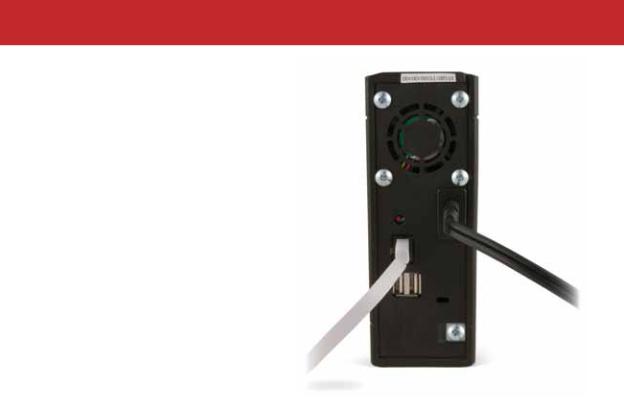
Connecting your LinkStation
Begin by plugging your power cable and Ethernet cable into the back of the LinkStation as shown.
4
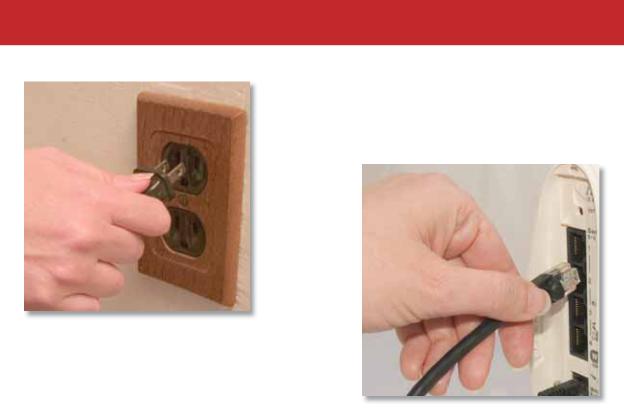
Connect your Cables
Plug the power cord into a 120 volt wall socket or surge protecter.
Plug the other end of the Ethernet cable into a hub, router, or switch in your network.
5
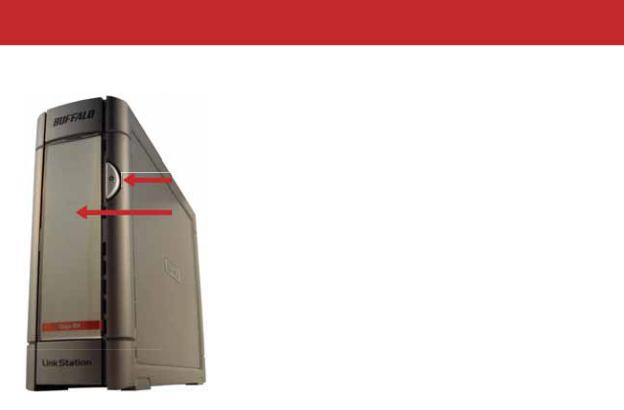
Powering up
Press the power button on the front panel. LEDs will blink as your LinkStation boots up.
After your LinkStation has completed booting up, check the LINK/ ACT LED on the front of the LinkStation. If it’s lit, then your LinkStation is connected properly, and you can go on to page 8. If it’s not lit, turn to page 7 for troubleshooting.
6

Setup Notes
The LinkStation’s Ethernet port will automatically adjust to use either a crossover or catch cable, so you may connect the LinkStation to your network with either type of Ethernet cable. Buffalo Technology doesn’t recommend connecting the LinkStation directly to a PC.
Verify that the LINK/ACT LED on the front of LinkStation is lit (see page 6’s picture). If it’s lit, go to page 8 to continue setting up LinkStation. If the LINK/ACT LED is still not lit, try the suggestions below to verify that you’re not suffering from common setup problems.
Having problems? Make sure that:
•the LinkStation and the router, hub or switch are both powered on,
•the Ethernet cable is securely plugged in at both ends, and
•the Ethernet cable is not damaged. Verify this by trying a different Ethernet cable.
If problems persist, you may contact Buffalo Technology’s technical support. See pages 55 and 56 for technical support contact information.
7
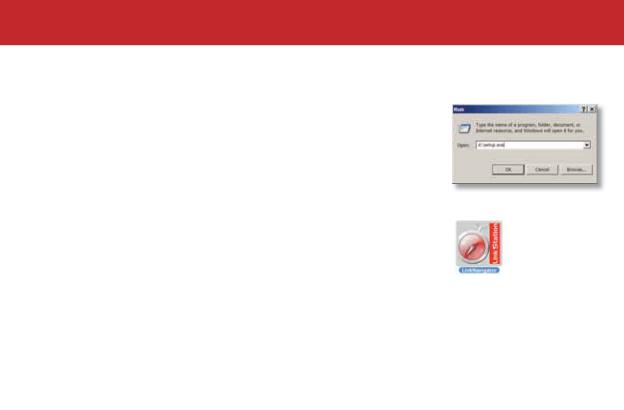
Installing Software
Insert the LinkNavigator CD into your computer’s CD-ROM drive.
On a PC, setup should automatically launch. If it does not, manually launch setup.exe by pressing Start and selecting the Run... option. When the Run dialog opens, type d:\setup.exe (where d is the drive letter of your CD-ROM drive). Press OK to continue.
If you are installing the software on a Mac, open the CD and click LinkNavigator to begin installation.
8

LinkNavigator Setup
Press the Begin Installation button to begin.
If you’re installing on a PC, click on Connect this PC to LinkStation (the green, lower button). Mac users can skip this step.
Click Next to step through the installation.
9

LinkNavigator Setup
Continue pressing Next to step through the installation.
When installation is complete, you may close the installation window.
10

Using your LinkStation with a Windows PC
Two new icons will be on your desktop: Shortcut for LinkStation and
Buffalo NAS Navigator.
Clicking Shortcut for LinkStation takes you directly to the folders on your LinkStation. Share is the main folder that you can put files and folders in. Info contains a copy of your user manual.
The Buffalo NAS Navigator icon opens the LinkStation’s client utility. Turn to page 55 for more on using the NAS Navigator client utility.
11
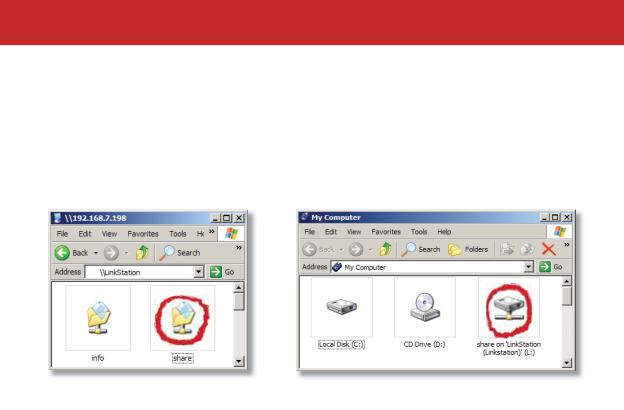
Accessing LinkStation Data from your PC
To Access LinkStation Data from a PC:
Your LinkStation uses “shares” (folders) to hold data. A share called “share” is already configured on your LinkStation, and you can create additional shares on page 30. To start using your LinkStation, you can either click on the Shortcut for LinkStation on your desktop, or you may just use drive L in My Computer, which setup has mapped to the default share in your LinkStation.
12

Using your LinkStation with a Mac
After installing the LinkNavigator software, your Mac will have two new icons on the desktop.
The Share folder is the main folder that you can put files and folders in. NAS Navigator is the LinkStation’s client utility.
Clicking Share opens the main folder on your LinkStation. You can put files and folders in Share as though it were any other hard drive connected to your computer. You may add additional shares to your LinkStation on page 30.
The NAS Navigator icon opens the LinkStation’s client utility. Turn to page 52 for more on using the NAS Navigator client utility.
13
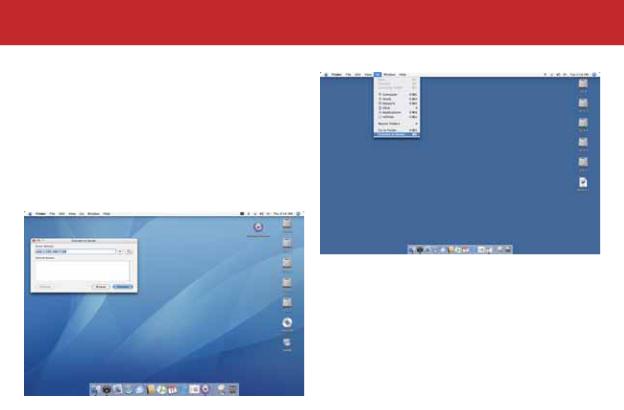
Accessing LinkStation Data from a Mac
You can manually add LinkStation Shares (folders) to your desktop by adding them to the Mac’s server list. Begin by clicking Go, and then choose Connect to Server.
In the Server Address field, enter your LinkStation’s IP address in the form smb:// ipaddress (where “ipaddress” is your LinkStation’s IP address), and click Connect.
If you don’t know your LinkStation’s IP address, see page 16.
14
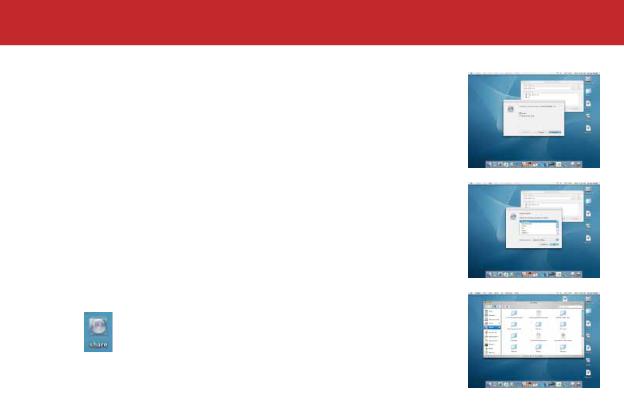
Accessing LinkStation Data from a Mac
Select Guest and click on Connect. Note: If you have configured share permissions on your LinkStation, select Registered User and enter your Registered User credentials.
Select the volume that you want to mount, such as share or share-mac, from the list of folders on the LinkStation.
The share will open. A link to the shared folder will appear on your desktop.
15
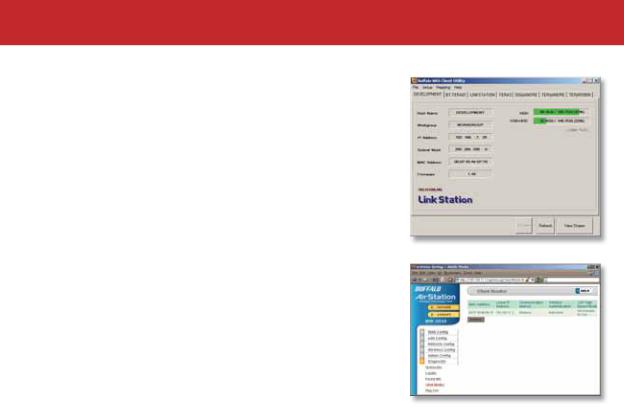
Accessing LinkStation Data from a Mac
If you don’t know your LinkStation’s IP address, there are several ways to get it.
One simple method is to use the NASnavigator client Utility (included on your CD) to find your LinkStation(s). Just click on the tab for your LinkStation and you’ll be able to read its IP address. See page 55 for more on the LinkStation client utility.
You can always get the LinkStation’s IP address from your router’s configuration utility. Many Buffalo routers list this information on the Client Monitor page, as shown to the right. Consult your router’s documentation for instructions on identifying the LinkStation’s IP address.
16

LinkStation Expansion
LinkStation Pro has two USB 2.0 ports on the rear. These ports can be used for adding external USB Hard Drives or a USB Printer. LinkStation will share connected USB storage devices, allowing everyone on the network to use them. Up to two external USB hard drives may be added to LinkStation Pro. To connect a USB hard drive or printer to your LinkStation, simply plug it into one of the USB ports.
Once your USB hard drive is connected, see page 27 for configuring your LinkStation to use it. See page 30 for information on setting up shared folders on a USB Hard Drive. Page 29 will show you how to reformat the USB Hard Drive. Page 39 and 40 show you how to set up LinkStation to backup to a USB Hard Drive.
See page 57 to set up Windows PCs to print to a USB Printer on your LinkStation.
17
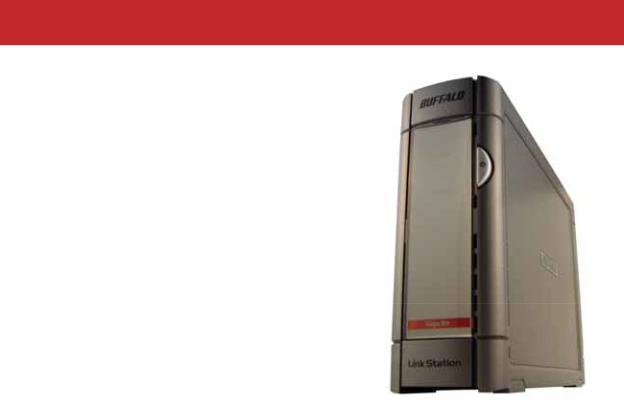
LinkStation Layout
Power Button – Press and release the Power Button to turn the LinkStation on. Hold it down for three seconds to turn the LinkStation off.
Link/Act LED – The Link/Act LED glows green when the LinkStation is connectied to a network. It blinks when the LinkStation is sending or receiving data.
Info LED – The Info LED blinks when you have a message waiting for you in the client utility.
Diag LED – The Diagnostic LED blinks to signal abnormal operation. See page 60 for a list of Diagnostic LED codes.
18
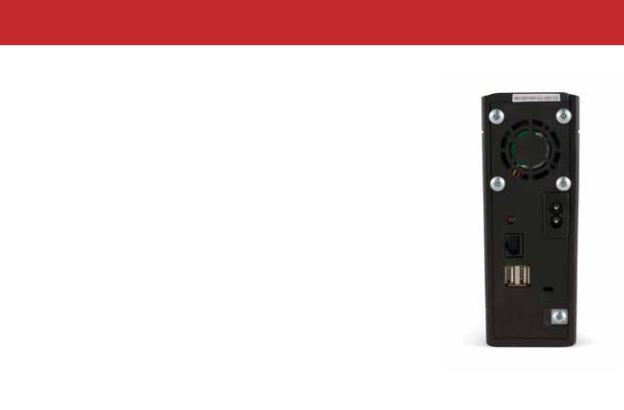
LinkStation Layout
Init button – The red Init button allows you to return your LinkStation to factory defaults.
10/100/1000 Mbps Ethernet Port – Use this port to connect your LinkStation to a switch, a router, or another computer. The port is autosensing, so either a conventional Ethernet cable or a crossover Ethernet cable may be used.
USB Ports – LinkStation offers two USB 2.0/1.1 ports for adding external drives or a USB printer. See page 17 for more on using the LinkStation’s USB ports.
19
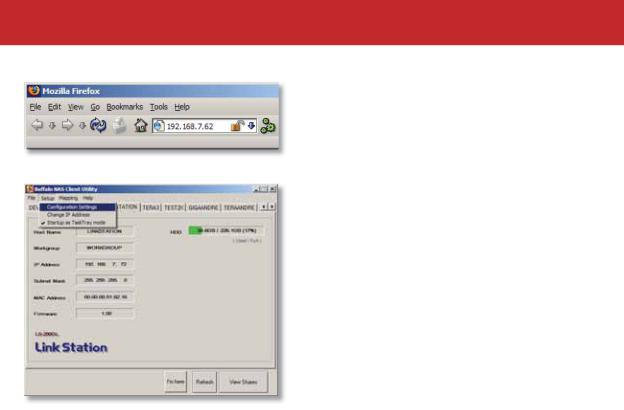
Advanced Settings
The Configuration GUI
The Configuration GUI may be accessed at any time by typing the IP address of your LinkStation into the URL bar of a browser running on a computer connected to the same network as the LinkStation. This works perfectly with OS X, Linux, and other non-Windows PCs.
If you have a PC running the Buffalo NAS Client Utility, you can get to the Configuration GUI by clicking on Setup and choosing Configuration Settings.
20
